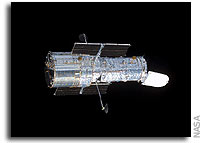NASA Hubble Space Telescope Daily Report #4307

HUBBLE SPACE TELESCOPE DAILY REPORT # 4307
– Continuing to collect World Class Science
PERIOD COVERED: UT February 26, 2007 (DOY 057)
OBSERVATIONS SCHEDULED
ACS/SBC 10862
Comprehensive Auroral Imaging of Jupiter and Saturn during the International Heliophysical Year
A comprehensive set of observations of the auroral emissions from Jupiter and Saturn is proposed for the International Heliophysical Year in 2007, a unique period of especially concentrated measurements of space physics phenomena throughout the solar system. We propose to determine the physical relationship of the various auroral processes at Jupiter and Saturn with conditions in the solar wind at each planet. This can be accomplished with campaigns of observations, with a sampling interval not to exceed one day, covering at least one solar rotation. The solar wind plasma density approaching Jupiter will be measured by the New Horizons spacecraft, and a separate campaign near opposition in May 2007 will determine the effect of large-scale variations in the interplanetary magnetic field {IMF} on the Jovian aurora by extrapolation from near-Earth solar wind measurements. A similar Saturn campaign near opposition in Jan. 2007 will combine extrapolated solar wind data with measurements from a wide range of locations within the Saturn magnetosphere by Cassini. In the course of making these observations, it will be possible to fully map the auroral footprints of Io and the other satellites to determine both the local magnetic field geometry and the controlling factors in the electromagnetic interaction of each satellite with the corotating magnetic field and plasma density. Also in the course of making these observations, the auroral emission properties will be compared with the properties of the near-IR ionospheric emissions {from ground-based observations} and non thermal radio emissions, from ground-based observations for Jupiter?s decametric radiation and Cassini plasma wave measurements of the Saturn Kilometric Radiation {SKR}.
WFPC2 11024
WFPC2 CYCLE 15 INTERNAL MONITOR
This calibration proposal is the Cycle 15 routine internal monitor for WFPC2, to be run weekly to monitor the health of the cameras. A variety of internal exposures are obtained in order to provide a monitor of the integrity of the CCD camera electronics in both bays {both gain 7 and gain 15 — to test stability of gains and bias levels}, a test for quantum efficiency in the CCDs, and a monitor for possible buildup of contaminants on the CCD windows. These also provide raw data for generating annual super-bias reference files for the calibration pipeline.
FGS 10989
Astrometric Masses of Extrasolar Planets and Brown Dwarfs
We propose observations with HST/FGS to estimate the astrometric elements {perturbation orbit semi-major axis and inclination} of extra-solar planets orbiting six stars. These companions were originally detected by radial velocity techniques. We have demonstrated that FGS astrometry of even a short segment of reflex motion, when combined with extensive radial velocity information, can yield useful inclination information {McArthur et al. 2004}, allowing us to determine companion masses. Extrasolar planet masses assist in two ongoing research frontiers. First, they provide useful boundary conditions for models of planetary formation and evolution of planetary systems. Second, knowing that a star in fact has a plantary mass companion, increases the value of that system to future extrasolar planet observation missions such as SIM PlanetQuest, TPF, and GAIA.
WFPC2 11023
WFPC2 CYCLE 15 Standard Darks – part 1
This dark calibration program obtains dark frames every week in order to provide data for the ongoing calibration of the CCD dark current rate, and to monitor and characterize the evolution of hot pixels. Over an extended period these data will also provide a monitor of radiation damage to the CCDs.
WFPC2 11029
WFPC2 CYCLE 15 Intflat Linearity Check and Filter Rotation Anomaly Monitor
Intflat observations will be taken to provide a linearity check: the linearity test consists of a series of intflats in F555W, in each gain and each shutter. A combination of intflats, visflats, and earthflats will be used to check the repeatability of filter wheel motions. {Intflat sequences tied to decons, visits 1-18 in prop 10363, have been moved to the cycle 15 decon proposal xxxx for easier scheduling.} Note: long-exposure WFPC2 intflats must be scheduled during ACS anneals to prevent stray light from the WFPC2 lamps from contaminating long ACS external exposures.
WFPC2 11084
Probing the Least Luminous Galaxies in the Local Universe
We propose to obtain deep color-magnitude data of eight new Local Group galaxies which we recently discovered: Andromeda XI, Andromeda XII, and Andromeda XIII {satellites of M31}; Canes Venatici I, Canes Venatici II, Hercules, and Leo IV {satellites of the Milky Way}; and Leo T, a new “free-floating” Local Group dwarf spheroidal with evidence for recent star formation and associated H I gas. These represent the least luminous galaxies known at *any* redshift, and are the only accessible laboratories for studying this extreme regime of galaxy formation. With deep WFPC-2 F606W and F814W pointings at their centers, we will determine whether these objects contain single or multiple age stellar populations, as well as whether these objects display a range of metallicities.
WFPC2 11096
Hubble Heritage imaging of Jupiter during the New Horizons encounter HST Proposal 11096
WFPC2 images of Jupiter in Feb 2007 in support of New Horizons flyby of Jupiter. This Hubble Heritage DD program is working in concert with the existing GO programs by John Clarke {10862} and John Spencer {10871}.
FLIGHT OPERATIONS SUMMARY:
Significant Spacecraft Anomalies: (The following are preliminary reports of potential non-nominal performance that will be investigated.)
HSTARS:
10716 – GSAcq(2,1,1) Failed to RGA Hold GSAcq (2,1,1) scheduled 058/02:27:22 – 02:34:45 failed to RGA Hold (Gyro Control) due to mnemonics QF2STOPF and QSTOP flagging.
OBAD #1 RSS: 1446.83 a-s
OBAD #2 RSS: 5.34 a-s
OBAD MAP: not scheduled
COMPLETED OPS REQUEST: (None)
COMPLETED OPS NOTES: (None)
SCHEDULED SUCCESSFUL FGS GSacq 08 07 FGS REacq 05 05 OBAD with Maneuver 26 26
SIGNIFICANT EVENTS: (None)








